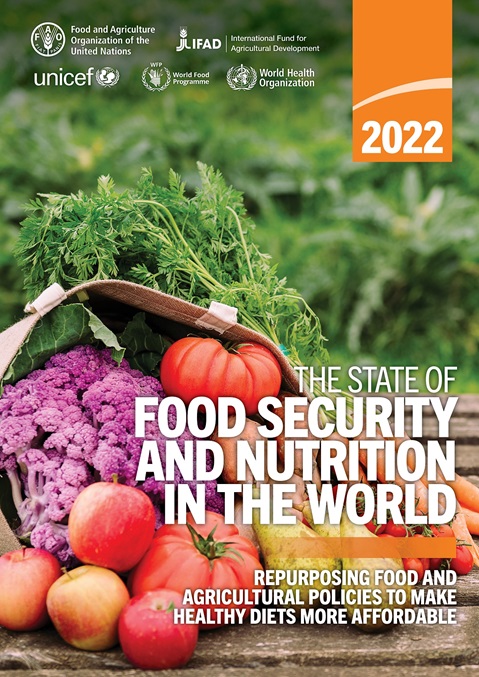
EBRD extends $ 21.3 m loan to Red Sea wind energy farm in Egypt
The European Bank for Reconstruction and Development (EBRD) is supporting the development and sustainability of ...

The State of Food Security and Nutrition in the World 2022 report shows that governments can invest in food systems equitably and sustainably, even with the same level of public resources. Governments’ support for food and agriculture accounts for almost $ 630 billion per year globally.
Globally, more than 3 billion people cannot afford a healthy diet. Unhealthy diets cause millions of deaths per year through, for example, inadequate consumption of whole grains, legumes, vegetables and fruit, and high consumption of sodium/salt, sugars and harmful fats, according to the report.
The report reveals the heavy global burden of hunger and malnutrition in all its forms. The lingering effects of the COVID-19 pandemic — along with disruption to the food supply caused by intensified conflict and extreme climate events — continue to impede progress towards achieving the Sustainable Development Goals (SDG) targets.
A key message of the report is that current government support to the food and agricultural sectors is often not aligned with the promotion of healthy diets.
This report shows how re-aligning food and agriculture policies can increase access to nutritious foods and make food systems more healthy, equitable and sustainable.
Existing public budgets need to be allocated in different ways, to stimulate production of more nutritious foods, increase their availability and reduce their costs so that healthy diets can be affordable.
At the same time, other food system policies need to complement these efforts to increase their impact by creating incentives and supportive environments for healthy diets.
The World Health Organization (WHO) supports countries’ efforts to improve food systems with a package of priority action including taxing unhealthy foods and subsidizing healthy options, protecting children from harmful marketing, ensuring clear nutrition labels, reducing the salt, sugars and harmful fats in processed foods, fortifying staple foods, improving meals in schools and hospitals, and strengthening national food control systems.
Healthy public food procurement and service policies, for example, have untapped potential. Healthy public food procurement and service policies involve governments setting criteria for food served or sold in public settings or food purchased with government funds.
Public settings, such as government offices, schools, childcare facilities, nursing homes, hospitals and all other canteens of public institutions, can play a key role in ensuring people are provided with nutritious, safe and healthy food. Often, meals and snacks in these settings do not align with healthy diet recommendations.
The full potential of healthy public food procurement and service policies is not yet being realized — although 93 countries are implementing food procurement policies in schools, there is little action in other settings.
To support countries in these efforts, WHO provides guidance in the Action framework for developing and implementing public food procurement and service policies for a healthy diet.
There are three main ways in which healthy public food procurement and service policies can complement the repurposing agenda.
The three ways include stimulating the supply of nutritious food by creating large-scale predictable demand and making production more economically viable.
The scale of institutional buying and the structured nature of public sector purchasing processes, can create large-scale, predictable demand for nutritious foods, especially perishable foods. Millions of meals and snacks are served or sold in public settings every day, and public procurement is big business.
A significant proportion of funds used for government buying — between 12 and 20% of countries’ GDP — are spent on food and could be redirected towards delivery of healthy diets.
This can in turn increase the economic viability of producing such foods, reducing the risk for smallholder farmers and creating an accessible, guaranteed market. Implemented broadly, healthy public procurement policies have the potential to stimulate the production of fruits, vegetables and other nutritious foods.
Public food procurement policies can also encourage a shift towards more sustainable food production methods.
The three ways also include shaping eating habits and shifting demand and consumption patterns towards healthier food.
Through their wide reach, healthy food procurement and service policies have enormous potential to shape eating habits and shift demand towards healthier diets. This in turn can stimulate increased production of nutritious foods at lower costs. The policies can be implemented at national, regional or municipal level depending on the division of responsibilities for public procurement.
The last one of the three ways is improving the access of at-risk groups to healthy diets and supporting vulnerable food system actors.
The changes as a result of repurposing of food and agricultural support policies can have unintended consequences. For example, they can lead to short-term livelihood insecurity and loss of income during the transition. Healthy public procurement policies can help mitigate these effects. This can be done by improving the access of at-risk groups to healthy diets, protecting vulnerable food system actors, supporting businesses that meet decent employment criteria and contributing to equity. An expansion of social protection programs that involve public food procurement — such as school feeding programs or food assistance — may be needed to protect vulnerable groups during the transition phase.
It is important that the foods provided through these forms of social protection contribute to healthy diets.
Healthy public food procurement and service policies are part of the WHO promoted package of game changing food systems for health actions. These actions focus on improving the nutritional quality of food along the food supply chain and creating healthier food environments.
The European Bank for Reconstruction and Development (EBRD) is supporting the development and sustainability of ...
The Food and Agriculture Organization of the United Nations (FAO), in partnership with the Azerbaijan ...
About 18 new green shipping corridor initiatives emerged worldwide in the last year alone – ...


اترك تعليقا